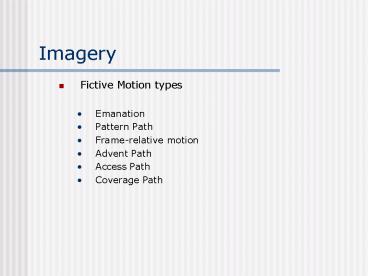Imagery - PowerPoint PPT Presentation
1 / 24
Title:
Imagery
Description:
Imagery. Fictive Motion types. Emanation. Pattern Path. Frame-relative motion. Advent Path ... Fictive motion of something intangible emerging from a source. ... – PowerPoint PPT presentation
Number of Views:32
Avg rating:3.0/5.0
Title: Imagery
1
Imagery
- Fictive Motion types
- Emanation
- Pattern Path
- Frame-relative motion
- Advent Path
- Access Path
- Coverage Path
2
Imagery
- Emanation
- Fictive motion of something intangible emerging
from a source. - Source object is active-determinative entity
- Agency
- Energy, power
- Size
- Concreteness
3
Imagery
- Access Path
- Stationary objects location depicted in terms
of a path that some entity might follow to it. - The bakery is across the street from the bank.
- The ball rolled across the street from the bank.
- The vacuum is down around behind the clothes
hamper. - I extended my arm down around behind the clothes
hamper.
4
Imagery
- Coverage Path
- Depiction of the form, orientation or location
of a spatially extended object in terms of a path
over the objects extent. - The fence goes/zigzags/descends from the plateau
to the valley - The field spreads out in all directions from the
granary.
5
Imagery
- Imagery
- Perception-like experiences accompanying language
comprehension or thought - Perception - perceiving a scene produces a mental
representation of objects, their spatial
relationships (or other perceptual
characteristics), awareness of how scene is
changing over time, identification of
event/state, awareness of reality of experience - Consciously imagining a scene or comprehending a
sentence describing a scene produces an
experience similar in some ways to perception but
without reality experience
6
Imagery
- Reality experience (from Talmy)
- Palpability
- Clarity, strength, ostension
- Objectivity
- Localizability, actionability
- Identifiability, certainty
- Conscious awareness
7
Imagery
- Ception (Talmy)
- Gradient experience of event representation
- High end - perception reality experience
- Mid-range - imagery
- Low end - association
- Actions
- Affective states
- Knowledge about
8
Imagery
- Evidence for imagery (Baddeley)
- Memorizability of imageable objects gt
non-imageable - Instruction to use imagery in memorization
increased learning lists of words
9
Imagery
- Analog vs. propositional representation
- Analog - imagistic representations are similar to
perceptual representations - Kosslyn
- Sheppard Metzler
- Propositional - imagistic representations are not
visual or spatial. Perceptual relationships do
not directly carry over to mental
representations. - Plyshyn
10
Imagery
Sheperd Metzler experiment on mental rotation
11
Imagery
- Image size (Kosslyn)
- Questions about imagined objects could be
answered more quickly in contexts were object of
interst was more saliently construed. - Ex. Imagine a rabbit next to a larger or
smaller animal then answer questions about the
rabbit. Faster response when rabbit next to
smaller animal.
12
Imagery
- Imagine an elephant standing next to a rabbit
13
Imagery
- Does the rabbit have a beak?
14
Imagery
- Imagine a fly standing next to a rabbit
15
Imagery
- Does a rabbit have eyebrows?
16
Imagery
- Kosslyn studies - boat picture
- Subjects look at and memorize picture of boat
- Asked questions about various parts of boat
- Questions took longer to answer if preceding
question pertained to more distant part of boat
17
Imagery
- Kosslyn studies - geographical representations
- Subjects asked questions regarding distances
between landmarks on a familiar university
campus. - How far is it from Peterson Hall to the Cog Sci
Building? - How far is it from Peterson Hall to Rimac?
- Decisions times correlated with actual distances
18
Imagery
- Kozlowski Bryant (1977)
- people self identified as having a good sense of
direction were better at pointing to places on
campus but no better than anyone else at pointing
north. - Some indication that representations of locations
are non propositional
19
Imagery
- Is imagery visual or spatial?
- Visual system provides color and spatial
information - Logie experiment
- subject faces screen
- colored patches appeared at regular intervals.
- Subject instructed to ignore
- Subject tried to learn word lists using either
visual imagery or a verbal rehearsal strategy. - colored patches caused significant drop in
performance on imagery condition but not rote
learning
20
Imagery
- Neuropsycholgy
- Kosslyn the monks
- Participants memorized drawings, then later had
to visualize them with their eyes closed and
answer the same questions asked while vieweing
them. Their brains were scanned during both parts
of the experiment. - 90 percent of the same areas of the brain were
actively occupied during both tasks. Every bit of
the brain activated when they saw the drawings
was also activated when they imaged them.
21
Imagery
- Regional blood flow monitoring (Ingvar 1979)
- Different tasks lead to a differential rate of
blood flow in different parts of the brain - left hemisphere - language
- frontal lobes - complex tasks
22
Imagery
- 3 tasks
- counting backwards in threes from 50
- imagining a jingle and deleting alternate words
- visualize taking a walk through familiar location
and alternately taking left and right turns - Task 3 produced blood flow in same regions as
during visual processing
23
Imagery
- Davidson Schwartz
- alpha-rhythms occur in perceptual parts of brain
associated with periods of non-activity - occipital - visual
- parietal - touch
- Subjects image either
- a regularly flashing light
- a regular tap on the arm
- both
24
Imagery
- Results
- Condition 1 (visual imaging) --gt occipital
alpha-pattern suppressed - Condition 2 (touch imaging) --gt parietal alpha
pattern suppressed - Condition 3 (both) --gt alpha pattern suppressed
in both occipital and parietal lobes































